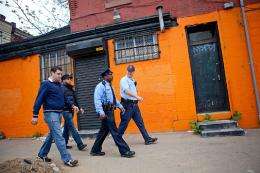Study recommends fighting crime the old-fashioned way

(PhysOrg.com) -- Researchers from Temple’s Department of Criminal Justice, in collaboration with the Philadelphia Police Department, have found a way to reduce violent crime in some of the city’s most dangerous locations. And it doesn’t involve hi-tech equipment or fancy CSI-like crime lab techniques.
Rather, it just takes good, old-fashioned shoe leather — in the form of community-based foot patrols.
For the study, Professor of Criminal Justice Jerry Ratcliffe and his research team analyzed data from across the city and mapped out the most violent street corners to identify the areas in greatest need of intervention. Next, 250 officers walked the beat in 60 of the city’s highest crime locations during the summer of 2009.
Researchers found that violent crime decreased by 22 percent.
And while the researchers did find some displacement of crime to nearby areas, overall the analysis showed that even after accounting for the shifts there were 50 fewer violent crimes last summer in Philadelphia than there would have been without the foot patrols.
“The long-held belief was that foot patrols made people feel good but didn’t actually do anything to prevent crime,” said Ratcliffe. “Our results may spark a revision of that view.”
Ratcliffe is a former police officer with the London Metropolitan Police, where he served as a patrol officer, in an intelligence and information unit and as a member of the Diplomatic Protection Group. As a researcher, he now focuses much of his work on ways to improve police work — through the use of strategic thinking and intelligence-led policing.
Police Commissioner Charles H. Ramsey, who himself started out on a foot beat in Chicago, believed that adding foot patrols would be effective, but wanted to have objective data. That led to the partnership.
“We often dedicate our resources to combat crime without knowing precisely what the effect will be, or fully understanding how to allocate our resources,” said Ramsey. “Our research partners at Temple have done a terrific job here in helping us make informed decisions about how to deploy police personnel in the field to get the best results in crime reduction and community satisfaction.”
According to Ratcliffe, one thing that makes Temple’s study so unique is the level of collaboration with the police department. While conducting the study, Temple’s graduate-student researchers actually walked the beats with city officers.
Now in phase two of the study, researchers are digging deeper. They are conducting interviews with officers to determine what types of interventions were most effective. For example, some officers engaged in considerable community-oriented work, speaking to community members and visiting child care centers and juvenile hangouts, while others were more crime oriented, stopping vehicles and conducting field interviews of pedestrians.
More information: Further information can be found at the project web site, www.temple.edu/cj/FootPatrolProject
Provided by Temple University














